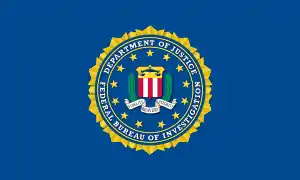FBI Critical Incident Response Group
The Critical Incident Response Group (CIRG) is a division of the Criminal, Cyber, Response, and Services Branch of the United States Federal Bureau of Investigation. CIRG enables the FBI to rapidly respond to, and effectively manage, special crisis incidents in the United States.
| Federal Bureau of Investigation | |
|---|---|
 | |
 Badge of the Federal Bureau of Investigation | |
 | |
| Common name | Federal Bureau of Investigation |
| Abbreviation | FBI |
| Motto | Fidelity, Bravery, Integrity |
| Agency overview | |
| Formed | July 26, 1908 |
| Employees | 35,104[1] (October 31, 2014) |
| Annual budget | US$8.3 billion (FY 2014)[1] |
| Jurisdictional structure | |
| Federal agency (Operations jurisdiction) | United States |
| Operations jurisdiction | United States |
| Legal jurisdiction | As per operations jurisdiction |
| Governing body | U.S. Department of Justice |
| Constituting instrument | |
| General nature | |
| Operational structure | |
| Headquarters | J. Edgar Hoover Building Northwest, Washington, D.C. |
| Sworn members | 13,260 (October 31, 2014)[1] |
| Unsworn members | 18,306 (October 31, 2014)[1] |
| Agency executives |
|
| Child agencies | |
| Major units | 5
|
| Field offices | 56 (List of FBI Field Offices) |
| Notables | |
| People |
|
| Programs | |
| Significant Operations | |
| Website | |
| www | |
History
In response to public outcry over the standoffs at Ruby Ridge, Idaho, and of the Branch Davidians in the Waco Siege, the FBI formed the CIRG in 1994 to deal more efficiently with crisis situations. The CIRG is designated to formulate strategies, manage hostage or siege situations, and, if humanly possible, resolve them "without loss of life," as FBI Director Louis Freeh, who assumed the post four-and-a-half months after the Waco fire, pledged in a 1995 Senate hearing.
CIRG was intended to integrate tactical and investigative resources and expertise for critical incidents which necessitate an immediate response from law enforcement authorities. CIRG will deploy investigative specialists to respond to terrorist activities, hostage takings, child abductions and other high-risk repetitive violent crimes. Other major incidents include prison riots, bombings, air and train crashes, and natural disasters.
Organization
Each of the major areas of CIRG furnishes distinctive operational assistance and training to FBI field offices as well as state, local and international law enforcement agencies.
- Surveillance and Aviation Section - Provides aviation and surveillance support for all facets of FBI investigative activities with a priority on protecting the United States from terrorist attack and against foreign intelligence operations and espionage.
- Aviation Surveillance Branch
- Aviation Support Unit
- Special Flight Operations Unit
- Field Flight Operations Unit
- Mobile Surveillance Branch
- Mobile Surveillance Teams-Armed (MST-A)
- Mobile Surveillance Teams (MST)
- Aviation Surveillance Branch
- Tactical Section - Provides the FBI with a nationwide, three-tiered tactical resolution capability that upon proper authorization can be activated within four hours of notification to address a full spectrum of terrorist or criminal matters.
- Operations and Training Unit
- Hostage Rescue Team
- SWAT Operations Unit
- Special Weapons and Tactics Teams
- Crisis Negotiation Unit
- Tactical Helicopter Unit
- Operational Support Unit
- Investigative and Operations Support Section - Prepares for and responds to critical incidents, major investigations, and special events by providing expertise in behavioral and crime analysis, crisis management, and rapid deployment logistics.
- National Center for the Analysis of Violent Crime
- Crisis Management Unit
- Rapid Deployment and Logistics
- Strategic Information and Operation Center - Serves as the FBI's 24-hour clearinghouse for strategic information, and as the center for crisis management and special event monitoring.
- Counter-IED Section - Provides training, equipment, and advanced technical support to prevent and effectively respond to terrorist or criminal use of hazardous devices explosives and weapons of mass destruction.
- Critical Incident Intelligence Unit - Provides intelligence to inform operational planning and strategic decision-making.
References
- "Frequently Asked Questions". Federal Bureau of Investigation. Retrieved 2016-09-02.